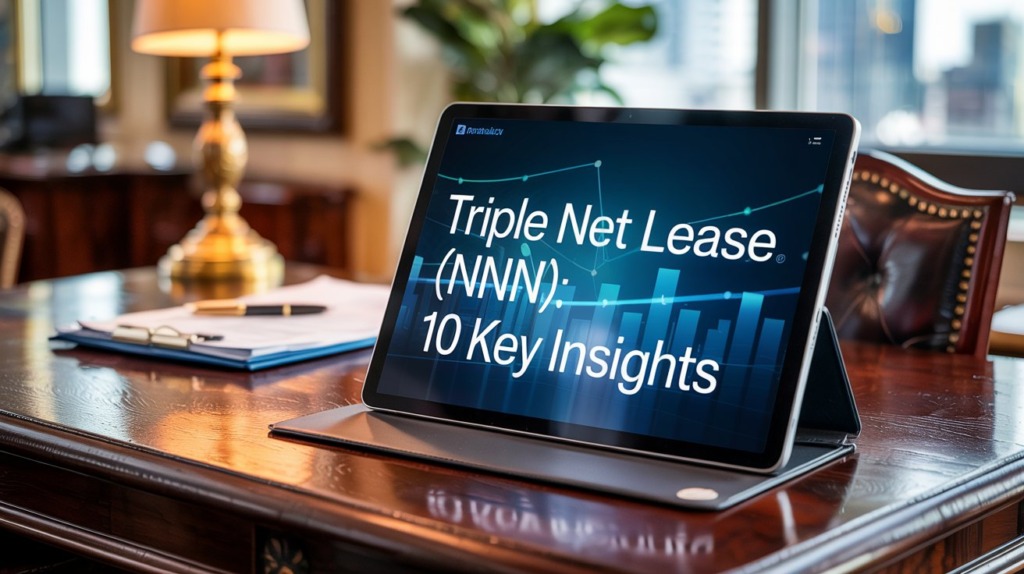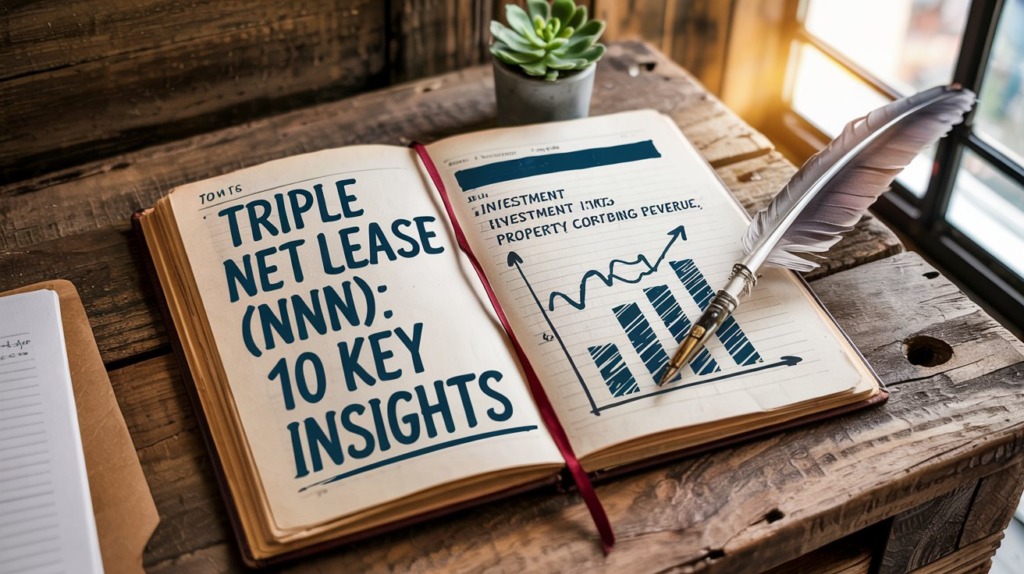The Triple Net Lease (N) is a widely used lease structure in commercial real estate. Its straightforward nature and potential for long-term profitability have made it a preferred choice for investors and tenants. Whether you’re an experienced real estate investor or new to commercial leases, understanding the details of this agreement can help you make informed decisions.
In this comprehensive guide, we will examine the Triple Net Lease (N), its benefits, drawbacks, and how it compares to other lease types. By the end of this article, you will have a clearer understanding of whether a Triple Net Lease is the right choice for your next investment.
What is Triple Net Lease (NNN)?
A Triple net lease (N) is a commercial lease agreement in which the lessee agrees to be responsible for the property taxes, insurance premiums, and other costs associated with the operation of the property. These expenses are known as the three nets:
Property Taxes
Insurance
Maintenance costs (repairs included)
This means the tenant has to cover these three extra costs in addition to the landlord’s rent. This provides landlords with assured and consistent cash flow, and the responsibility of property care lies solely with the tenant.
The “Three Nets” Explained:
Property Taxes are local government taxes assessed on property. In this situation, the tenant pays the full property taxes, not the landlord.
Insurance: The expense of insuring the home against loss would ordinarily be fire, damage or theft. Tenant to pay for property insurance premiums.
Maintenance Costs: Regular property maintenance, including cleaning, landscaping, plumbing repairs, and general upkeep. The tenant handles these and covers their costs in a Triple Net Lease.
In this arrangement, landlords do less administrative work and take on less risk with management because the tenants pay most of the operating costs. This grouping is more common for single-tenant properties like retail stores, medical offices, and industrial spaces.
What Are the Three Types of Triple Net Leases?
Although the framework of Triple Net Leases remains unchanged, the tenant type plays a role in how responsible they will be. With that in mind, let’s dive a little deeper into these variations:
Absolute Triple Net Lease (N)
An Absolute Triple Net Lease (N) is the most tenant-intensive version of the Triple Net Lease. In this arrangement, the tenant assumes responsibility for all property-related expenses—taxes, insurance, maintenance, and major repairs or structural issues. This type of lease provides the highest level of protection for landlords, as the tenant bears the full risk.
Under an Absolute NNN lease, the tenant is responsible for maintaining the property’s integrity, including structural elements such as the roof, foundation, and outer walls. This makes it an appealing option for landlords who want to shift the entire burden of property management onto the tenant.
Adjusted Triple Net Lease (me)
In a Modified Triple Net Lease (MNN), the tenant is responsible for property taxes, insurance, and maintenance costs. However, the landlord retains responsibility for certain property aspects, such as major repairs and structural issues. This lease structure provides a more balanced approach to operational expenses, where the tenant covers day-to-day costs while the landlord handles larger-scale issues.
The Modified Triple Net Lease is ideal when the tenant seeks more control over the property, but the landlord still needs to manage significant aspects throughout the property’s lifespan.

Double Net Lease (NN)
I’m jumping from “Triple” to “Double,” but a Double Net Lease (NN) is still a solid option. In a double net lease, the tenant is liable for property taxes and insurance, but the landlord is liable for maintenance costs and major repairs. With this type of lease, tenants save on maintenance and carry most operating expenses themselves..
Reasons to Invest in Triple Net Lease.
Triple Net Lease Properties can be an excellent option for investors looking for stable, long-term passive income. Here’s why buyers coveted Triple Net Leases.
Regular and Stable Income Source
Perhaps the most significant benefit of a Triple Net Lease is the consistent and predictable cash flow. Since tenants cover the rent and the property’s running costs, the landlord’s income is less affected by rising maintenance costs or increases in tax rates. This makes Triple Net Leases particularly appealing for investors seeking stable long-term income.
Triple Net Lease Agreements are usually made for longer terms, like 10-25 years. That means that investors can lock in a reliable source of income for the long run and will know where their income stream will be in years to come.
Less Responsibility for the Landlord
Triple net leases are great for real estate investors interested in minimal upkeep. Landlords are much less involved since tenants are responsible for most property costs. They do not have to deal with repairs, property taxes, or insurance, allowing investors to concentrate on the area of their portfolio or business.
This simplicity factor is a key draw for passive investors who aspire to own real estate without the responsibilities of dealing with contractors, tenants, and repairs.

Lower Vacancy Risk
Why Triple Net Leases Are Easily Taking Over the Real Estate Market: Reduced Vacancy Risk. These leases are long-term, meaning tenants are usually locked into paying rent for several years. Moreover, TW uses the Triple Net Lease, and many tenants are well-known companies with substantial financial backing. This reduces default risk and the hassle of frequent turnover for each tenant.
In addition, since tenants are responsible for covering the operating costs associated with the property, the landlord is less likely to be surprised by lost revenues from vacancies or increasing repair and upkeep costs.
The possibility of higher returns on investment
Triple Net Leases typically have higher rental rates, which can lead to more significant returns in the long run. Due to the security of the lease structure, investors may enjoy more favourable financing terms. Because lenders consider properties with Triple Net Lease less risky, such properties may qualify for more favourable loan terms for property owners.
The Dark Side of Triple Net Leases
Although investing in Triple Net Leases has some pitfalls to be cautious of, these come with a few pitfalls we’ll dig into.
Tenant Default Risk
Tenant default is the biggest threat to Triple Net Leases. What if a tenant is struggling financially or defaulting on the lease? In that case, the landlord might pay the operating costs for the property, including taxes, insurance and maintenance. If the tenant defaults early, this can severely affect the landlord’s profitability.
Before entering a Triple Net Lease, you should consider this and ensure the tenant’s financial stability, history of paying rent, and ability to maintain operational expenses.
Long-Term Commitment
Triple Net Leases often run for 10, 15, or even 25 years. For landlords, this longer commitment can be a double-edged sword. Long-term leases offer the landlord peace of mind in knowing they won’t have to worry about seeking a new tenant. However, this can come at the cost of reducing the landlord’s ability to adjust to market changes. In some cases, lease rates may be locked in over the length of the lease, creating an opportunity cost if market conditions improve.
And if the tenant becomes a bane or the market takes a downturn, landlords could find themselves stuck with less-than-ideal deals for years.
Maintenance and Repair Risks
Tenants are generally responsible for maintenance, but depending on the lease terms, the landlord may be responsible for some major repairs or even structural issues. For instance, problems with the foundation or roof may not be the tenant’s responsibility, meaning the landlord must take on these significant costs.
You should read the terms of the lease agreement carefully to learn which maintenance costs are borne by the tenant and which remain with the landlord.
How to Invest in Triple Net Leases
Here are some actionable steps you can take to invest in Triple Net Leases:
Research Potential Properties
Before investing, finding properties created for Triple Net Leases is essential. Invest in commercial real estate properties with high demand, like retail spaces, office buildings, or industrial properties. In all scenarios, you want to consider the tenant’s location, condition, and financial stability before proceeding.
Seek Guidance From Real Estate Experts
Given the complexity of Triple Net Leases, it’s essential to speak with a real estate professional who understands how this type of lease operates. An expert can assist you with understanding the lease agreement requirements, assessing the financial soundness of potential tenants and each investment’s potential legal or tax impacts.
Assess the Creditworthiness of the Tenant
One of the most important aspects of a Triple Net Lease is the tenant’s financial health. Please make sure the tenant’s economic history is strong and it’s a tenant likely to stick to long-term financial commitments. A tenant with a good credit rating is less likely to cause a payment default, thus giving you a more stable investment.
Understand the Lease Terms
Lastly, be informed of the terms within the Triple Net Lease before entering any agreement. Scrutinize the responsibilities assigned to the tenant and the landlord, including clauses about maintenance, repairs, rent escalations and lease renewals. Clearing up how these words are being used now will save you from unpleasant surprises later.
The Bottom Line: Is a Triple Net Lease Right for You?
Consistency of Income Stream: A Triple Net Lease (N) provides real estate investors with a steady, low-maintenance, and predictable income stream. This structure allows tenants to shoulder the burden of property taxes, insurance and maintenance, offering landlords stability over the long haul and less involvement in everyday property management. But like any investment, Triple Net Leases come with risks, notably tenant default and long-term commitment.
With some good research, help from a realtor, and careful analysis of lease contracts, you can get the most from an investment in Triple Net Leases while mitigating some of the possible risks.
“To explore more about real estate investment and strategies, visit Smart Realty Guide’s main page.”
Key Takeaways:
In NNN terms, and based on the NNN commercial properties for which we signed, the tenant pays property taxes, insurance, and maintenance, and the landlord benefits from a steady stream of income.
For investors, it offers long-term stability, less burdensome property management responsibilities, and the potential for more significant returns.
There are also downsides: the risk of tenant default, the long-term commitment, and the potential for unplanned maintenance costs.
If you are looking for a dependable and hands-free real estate investment, a Triple Net Lease might be just what you need. You have to read the delicacies of the lease agreement and be sure of the tenant’s financial situation in order to determine whether the investment will benefit you or not.
For a deeper understanding of how Triple Net Lease (NNN) agreements work, check out this comprehensive guide.
Frequently Asked Questions (FAQs)
Q1: What does a Triple Net Lease involve?
A Triple Net Lease is a contract where the tenant agrees to pay for property taxes, insurance, and maintenance in addition to the rent. This structure is common in commercial real estate.
Q2: How does this lease benefit investors?
Investors benefit from steady, passive income and reduced responsibility for property upkeep, as tenants cover many operational costs, lowering the landlord’s management burden.
Q3: Are there any risks associated with this type of lease?
While these leases provide steady income, risks include tenant default, property damage, or long vacancy periods if the tenant decides to leave.
Q4: What types of properties typically use this lease structure?
This type of lease is often found in commercial properties like retail centers, office buildings, and industrial facilities, where tenants can take on management responsibilities.
Q5: How is this lease different from a gross lease?
In a gross lease, the landlord pays for most expenses related to the property. In contrast, tenants under a Triple Net Lease cover these costs themselves, including maintenance and repairs.
Q6: Can individual investors purchase properties with this lease?
Yes, individual investors can purchase properties under this lease through direct transactions or investment vehicles like real estate investment trusts (REITs).
Q7: What are the main benefits for tenants in this arrangement?
Tenants often enjoy lower rent costs since they take on more responsibilities, and they have greater control over property maintenance and management decisions.




